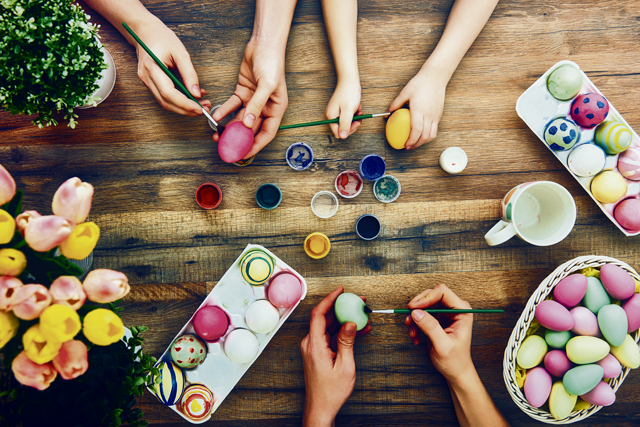
Decorating Easter eggs is a cherished tradition across Europe. But each country has its unique customs and styles, that may decisively vary.
According to a Lenten tradition, in Medieval Europe the consumption of eggs was forbidden during the 40-day period of fasting leading up to Easter. But since chickens continued to lay eggs, they were boiled or preserved to prevent them from spoiling. When Easter arrived, these eggs were then decorated and eaten as part of the celebration.
In Germany, the tradition of decorating Easter eggs is known as “Ostereier bemalen.” A common custom is that families come together and paint eggs with vibrant colors. Some techniques include dyeing, painting and using wax resistant methods to come up with astonishing patterns. Eggs are often used to decorate “Easter trees” or “Ostereierbäume” that can be found in village squares or private front yards.
A popular sport during the season is “Ostereierschiessen” (Easter egg shooting). But no worries, contestants shoot at paper goals marked with Easter figures or eggs with the aim of hitting as many “eggs” as possible. Each successful shot brings about a real egg and the winner of a whole tournament is crowned as the “Schützenkönig” (archer king).
In France, Easter egg decoration is less elaborate but still significant. Eggs are hand-painted with various designs, often reflecting spring themes like flowers, animals, and cheerful colors.
Another technique is decoupage: Decorative paper or fabric pieces are glued onto the eggs to create beautiful, textured designs. This technique allows for a wide range of artistic expression. Natural dyeing is also popular using materials such as onion skins, beetroot and spinach to achieve natural colors, often combined with leaf or flower imprints for additional decoration.
As in the United States and large parts of Europe, Easter egg hunts are a popular activity in England. Decorated real eggs or ones made from chocolate are hidden in gardens and parks. Some larger events take place in historic estates and contestants can win prizes for finding the most eggs.
Egg rolling is also a popular and fun tradition, played in some areas in England. Hard-boiled eggs are rolled down a hill or across a field and the goal is to see whose egg rolls the farthest without breaking.
In Poland, decorated eggs are called “pisanki.” They are made using a wax-resist technique or by painting intricate designs directly onto the eggs. Traditional designs often include geometric patterns, flowers, and religious symbols.
In the Czech Republic and Slovakia, decorating Easter eggs is an important tradition known as “kraslice.” The eggs are often decorated using a variety of techniques, such as painting, dyeing, and using wax or straw to create intricate designs. Traditional kraslice designs include geometric patterns, floral motifs, and symbolic images.
A special technique using straw is common where thin pieces are cut into shapes and glued onto the egg to form patterns. This technique requires precision and patience to create intricate, symmetrical designs. Eggs can also be etched, where they are first dyed in a dark color and then designs are etched into the shell using a sharp tool. This method creates delicate, white patterns against the dyed background. The eggs are used in Easter celebrations and cherished as precious gifts.
Hungarian Easter eggs are known as “hímestojás” and are traditionally decorated using various techniques, including painting, dyeing, and etching. The designs often feature intricate floral patterns, religious symbols, and motifs inspired by Hungarian folk art. The eggs are sometimes given as gifts or used in Easter games and festivities.
In Greece, Easter eggs are typically dyed a deep red color to symbolize the blood of Christ. The eggs are then blessed during church services and used in the traditional game of “tsougrisma,” where participants tap their eggs against each other to see whose egg remains uncracked.
In the Ukraine, the art of decorating eggs, or “pysanky,” is a highly revered and intricate craft. Pysanky are created using a wax-resistant method, where beeswax is applied to the egg in patterns, and then the egg is dyed multiple times in different colors. The wax is melted off to reveal the final, multicolored design. Each symbol and color used in pysanky has a specific meaning, often related to nature, faith, and folklore. Appliqué is a further tradition: In some regions, eggs are decorated by applying tiny pieces of fabric, lace, or other materials to the surface, creating a textured and colorful design.
In Russia, Easter egg decoration is a significant cultural practice, with some of the most elaborate and artistic techniques, such as pysanky. Eggs are decorated with beeswax patterns, dyed in stages, and then the wax is melted off to reveal intricate designs. Russian pysanky often feature geometric patterns, religious symbols, and motifs from nature. This can include religious icons, floral motifs, and traditional Russian patterns. Some eggs are painted with detailed scenes from cultural stories.
Last, but not least: Fabergé Eggs. Though not a traditional Easter egg decoration technique, the luxurious Fabergé eggs are world-famous. Created by the House of Fabergé for the Russian Imperial family, these eggs were crafted from precious metals and gemstones, featuring exquisite craftsmanship and elaborate designs. Each Fabergé egg often contained hidden surprises or miniature scenes.
Each of these traditions reflect the cultural heritage and artistic expression of the region, making Easter egg decorating a vibrant and meaningful part of European celebrations.
If you’re interested in learning and experiencing more about traditional egg decorating techniques, there is a series of Easter egg markets in historical monasteries where international artists will demonstrate their crafts. See “Unterwegs” for details and dates.


